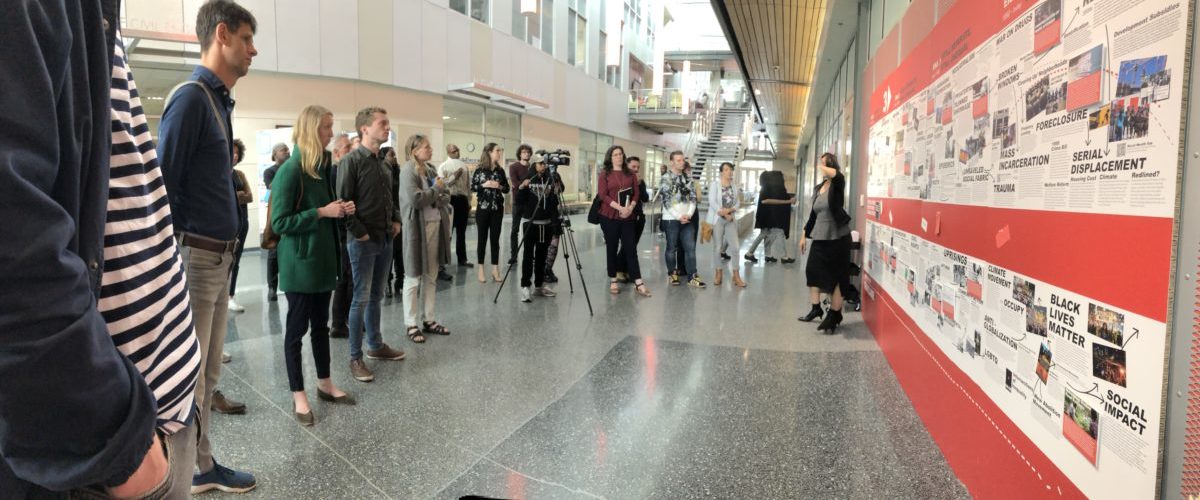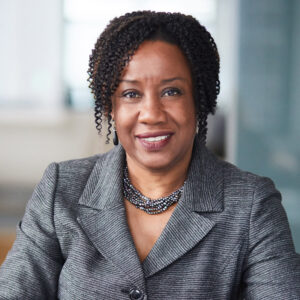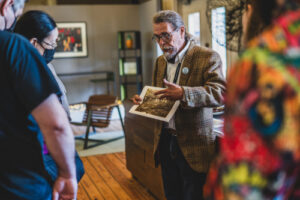
By Cristina Murphy
Baltimore, MD (May 10, 2019) – Who will Baltimore serve in 15 years? Overall, cities are struggling between accommodating new investments and avoiding displacement. Can spatial equity be addressed through market-based solutions or are community land trusts the only viable solution? Can designers provide innovative and creative ideas to address equity in the built environment?
On April 18, I organized a symposium at SA+P (School of Architecture and Planning) at Morgan State University in Baltimore that explored how redlining and gentrification have shaped and are still influencing Baltimore neighborhoods. This event was part of ARC540-Studio 4, a Morgan State University School of Architecture + Planning graduate studio investigating the meaning of a just city applied to Baltimore and Rotterdam. This spring 2019 design studio was curated in collaboration with the Rotterdamse Academie van Bouwkunst (RAvB), a Rotterdam based Design Academy with a curriculum is similar to what offered at Morgan. It was crucial to understand the legacy of the transformation of place, race, and class in Baltimore, and examine how redlining and other policies, practices, and disinvestments have created systemic disparities that not only perpetuate our most pressing social challenges, but impede democracy.
In order to unfold this rather complex matter, the symposium was laid out in five parts, all of which worked in conjunction to provide a context for the history and legacy of redlining:
Lectures:
Antero Pietila, author, Not in My Neighborhood: How Bigotry Shaped a Great American City, revealed the secret of American Cities’ urban planning structures and how persisting discrimination (racial and financial) has been a determining factor of how our cities are designed even today.
Wouter Veldhuis presented the concept of just cities and introduced case studies in the Netherlands. Here, the idea is to improve the life of the poor despite the presence of multi-national corporations attempting to flatten and globalize the socialist attitude of the country.
April de Simone, co-founder Designing the WE, based in NYC, narrated true stories of segregation, emphasizing how redlining is a structural tool that perpetuates institutionalized racism in laws and city services. How can city improvements happen when authorities allow for intentional community and neighborhood decay?
Panel Discussion:
This was an animated conversation among lecturers and audience on how redlining had, and still is, guiding American cities. Panelists included Antero Pietila, April de Simone, Wouter Veldhuis, Seema Iyer (Baltimore Neighborhood Indicators Alliance at JFI), Lori Rubeling (Stevenson University), Zevi Thomas, Assoc. AIA (AIA Baltimore), Nneka Namdi (Fight Blight Bmore), Colman Jordan (Morgan State University), and Jerome Gray, AIA (jerome c gray architect llc).
Exhibition “Undesign the Redline:”
We welcomed the “Undesign the Redline” exhibition at Morgan as part of the Redline in Baltimore Symposium. This amazing nomadic and interactive exhibition, designed by Designing the WE, walks us through how structural racism and inequity was designed into cities. This narrative unfolds in a larger historical context by diving narrating real people’s stories. The exhibit also facilitates, explores opportunities and alternatives that may continue to heal the legacy of redlining.
Discussion and Interaction:
Nneka N’namdi from Fight Blight Bmore shared experiences of those affected by redlining, blight, gentrification and displacement. N’namdi humanizes the lessons of history. She asks, “How are disinvested urban spaces impacting the health of the community?” N’namdi’s presentation gave us the opportunity to speculate on private interest and capital versus equity and inclusion.
Brainstorm:
Pigtown in Baltimore and Hillesluis in Rotterdam are Just City Studio case studies. On both sites, students attempt to apply alternative models to undesign the redlining legacy. The work of our student’s imagine integrated spaces for people and challenge decision-makers not to allow neighborhoods to fall into unrecoverable decay.
Testimonials:
After the Symposium, I asked a few guests to report their impressions:
Anthony Quivers: “There has never been a ‘symposium’ that has affected me in such a profound way. The conversations exposed me to the pathology and policy of structural racism. Think of all of the things that were created elsewhere but held back there because of known moral consequences. The shock is in how these same things, (i.e. slavery, modern capitalism), were later brought to America and implemented without restraint. The result was entire civilizations being wiped out and groups of people being enslaved. There is no narrative for reparations or reconciliation. Yet there are more silent methods being used to make people unaware of the history and keep others believing that these kind of injustices are the status quo. Morality is an idea. In the United States, repression happens at the level of an idea.”
Charles Eubanks – Activist/Organizer in Baltimore City: “Entering the symposium space at CBEIS on the Morgan State campus was dazzling. The space was open and bright, and there was a forest of TV cameras in the back of the room. I really enjoyed the plethora of delicious pastries and refreshments provided. My friend Cristina (who planned the symposium) welcomed me warmly soon after I arrived. The space was filled with smiling, talking people: faculty, students, and guests. I could tell that this would be a very special event, but even my anticipation failed to account for the power and interest embodied in the day’s proceedings. We heard first-hand a captivating account and description of redlining practices and their devastating effects on Baltimore’s poor communities, and particularly those of color. It was a deeply moving emotional and intellectual experience for me, as a white cis-male from the rural South. Hearing the keynote address from Antero Pietila was riveting, and I scribbled notes furiously. To hear his skillful, well-researched, personal account of the history of redlining in Baltimore was an invaluable experience for me. His lecture provided me with precious context for my organization’s (Democratic Socialists of America) current organizing work around Housing Justice in Baltimore City. The second speaker, Wouter Veldhuis was also incredibly captivating and informative. It was intriguing to hear a Dutch perspective on potential solutions for ‘just’ cities. The third speaker, April de Simone was excellent too. I experienced her mother’s personal story as a powerful emotional rollercoaster, and her story grounded the reality of economic genocide and disinvestment for communities of color in American cities.
I also enjoyed the walkthrough she provided of the Redesign the Redline exhibit, and I learned a lot from her presentation of various American policies and historical events as being refreshed institutionalized racial attacks on persons of color. I enjoyed the panel as well. I have two related pieces of feedback, and they really relate to timing, and the size and process of the panel. I would have loved to have more time with panel members, but the time frame and size of the panel really limited the ability of certain members to have their full say. Also, a panel moderator might have helped to direct the flow of this part of the symposium. My suggestion would be to have multiple, narrowly focused, smaller (four panelists + one moderator) panels for an hour or so each. I also would have loved to have more interaction and a longer time-frame to really dig in and digest the exhibit with April. All of these procedural updates would probably necessitate having a multi-day symposium, or extending the time-frame of the symposium into the evening and adding dinner (or allowing a break for dinner). All-in-all, the event was really well planned and executed, just certain parts left me wanting more, which is a great problem to have. I am so grateful for this day at Morgan. I will treasure this experience in memory, and I have already shared the live-stream video with many of my fellow organizers and peers. Understanding these policies and grounding them in historical events, along with their material impacts is absolutely critical to making better policy, political, design, and investment decisions going forward. We have to fully acknowledge and reckon with this problem in order to start solving it, and this event was a fantastic first moment in that process for me.”
Lori L. Rubeling, Professor of Art and Design, Stevenson University: “The ‘other’ is weaponized by politicians. Its continued use in American political spaces sustains polite racism. I think that citizen ignorance or inability to perceive the 400-year injustice of the slave trade is the heart of the issue. How might we narrate the slave trade injustice so that all Americans relate to it as their injustice, too? The City of Baltimore governance is a too-perfect example of just what happens to the ‘other’ whose citizenship is ‘less-than.’ Antero Pietila’s excellent research and reporting present Baltimore’s injustice narrative as it played out in City Hall. Here, institutionalized racism and bigotry are sustained by the city’s 1908 residential segregation laws. Throughout the 20th Century, Pietila provides us detail after detail of how segregation is sustained through a national-level execution of redlining neighborhoods, of denying the ‘other’ equal access to political representation, property ownership, educational advancement, and safety. How might Baltimore’s narrative transform into a ‘Just City’? How might ‘all men are created equal,’ American democracy idealism, become reimagined as a new citizen contract? The April 18th Baltimore Redlining Symposium offers us an opportunity to be a witness to redlining and gentrification injustice and inspires us to frame citizenship in new and inspiring ways to help us realize the ideal that all citizens are created equal.”
Naomi Wong Hemme, Candidate, Master of Architecture at Morgan State University: “I attended the morning session of the symposium. As I had some exposure of the subject of redlining through a previous NDC conference and from reading Richard’s Rothstein’s ‘The Color of Law,’ I came away from the symposium with messages of hope from the speakers. Specifically, I was inspired by the presentation of Prof. Wouter Veldhuis and Ms. April de Simone. Prof. Veldhuis laid out the basic needs of just urban neighborhoods, while Ms. de Simone shared her deeply personal account of the impact of redlining and planned shrinkage. As a designer, I have always wanted to create spaces that promote a just society, and while there are many resources out there on the subject, symposiums like this provide a safe space to have candid, non-judgmental conversations among people coming from the side of good will. I hope SA+P continues to lead this type of symposiums, and perhaps organizes sessions that dove into how designers and planners can create just communities or help remedy systematic injustice–from access to healthcare, healthful food options, to social connections. I think it takes sustained efforts to educate and support the next generation of designers and planners on this topic and provide forums like this for dialogues and networking.”
Ryan Eubanks, AIAS Architecture and Urban Design Student at Morgan State University: “The symposium was powerful! The speakers were very knowledgeable and helpful in sharing the unjust practices of the past and how they are still having an effect in today’s society. These lectures challenged me to take some time, and consider how I would feel if my narrative was a life marginalized and disregarded. It caused me to think about what an unfree life might be like. I pause to think about how redlining affected generations of minorities negatively. On the flip side, it causes me to feel regret the way the majority was given the priority for socioeconomic climbs. I believe there has to be some way to calculate the effects that greed has had on the Black community. We must find a way to make it right. We must find a way to lift the racism and improve the lives of those whom have been taken advantage of. If we can admit there are things we did wrong, then we must be willing to coffer restitution for those wrongs. The only way to arrive at equality is to offer the advantages to all and raise all citizens together to have what is owed. Until we are willing to make this step, we are damned to continue creating the same disparities between those who can and those who want to but are blocked from doing so.”
Saskia Naaf, Investigative journalist at Investico – Platform voor onderzoeksjournalistiek: “To me, it was a very informative day. I really liked the speakers Cristina arranged for us. Mr. Pietila, who zoomed in on the particulars on redlining and contract selling in Baltimore, and then Mrs. de Simone who gave a broader layout of racist laws and policies in the US, were excellent! Mrs. de Simone presentation was especially strong as it was a personal story and she seemed more activist than Mr. Pietila who was more calm and collected and factual in his presentation. I also liked the input of Mrs. N’namdi as she brought in the perspective of a Baltimore resident, and what residents can do. Overall, it was a very informative symposium with interesting speakers talking about different aspects of a very complicated problem that is redlining (and its effects) and discrimination in the housing market in general. From a Dutch perspective, the information the speakers shared with us was sometimes quite shocking, as we do have discrimination and racism in the Netherlands, but not on an institutional and legal level as in the USA. Also from a Dutch perspective, I think we are always thinking in terms of planning solutions, so I was wondering what has been tried to remedy this basic inequality in access to proper housing. A lot of small and bottom-up non-profit initiatives were mentioned by Mrs. N’namdi, but perhaps it would have been good to have someone representing government or someone involved with city planning at the table as well, to give an idea of how Baltimore is trying to tackle these problems with redlining and discrimination in mortgage lending, but also with segregated neighborhoods and vacancies. Later, Rachel Sengers, Chair Baltimore-Rotterdam Sister Cities Committee, gave me a book by Klaus Philipsen, ‘Baltimore: Reinventing an Industrial Legacy City’ and I must say that has been very informative: it talks about what has been tried with vacant properties and making the housing market more just and equitable.
Just one small point of feedback: the day was quite long because we had the student presentations afterwards. Towards the end it was hard to remain concentrated and give the students the attention they deserved. Some more breaks would’ve been nice, or perhaps a shorter program. Finally, the traveling presentation by Mrs. de Simone is a really cool way to share this information with a broader audience and make it more interactive. I also liked that there was plenty of room for discussion and questions.”
Urban redlining is a concept I only learned of a year ago at the Motor House in Baltimore when the “Undesign the Redline” exhibition was on display. Before that, my knowledge of the city was built around concepts such as renewal leading to progress and community’s improvement. Concepts like gentrification were incomprehensible to me at the time! Trained in Europe, any urban transformation is evolution; it is positive development and community oriented—a strategic plan to make life for all residents better.
Once in Baltimore, the reality of different urban structures that are driven by financial and racial circumstances dawned on me, and got me curious. How was I unaware of such a significant concept and, most importantly, such a massive driver of urban design? How was I not aware of how cities were divided? Is there a “White L” and “Black Butterfly” (Professor Lawrence Brown) in Baltimore? Are there undesirable areas, or is that a simplification, a perception built by realtors to steer markets? Today, I believe cities evolve following a financial logic, and now, more so, the structural organization of cities is still influenced by racial circumstances that are so challenging to resolve. I now believe that much of the American City’s genesis is driven by a strong cultural attitude we should challenge by providing a different perspective on how to design cities for people.
I am also glad this conversation is, today, entertained in the right setting: this is where the new generation of designers is forged. This is where we educate them to lead the future in the hope that they will shape better, more equitable and livable cities. This is where we can train them on the concept that justice is possible not as an option but as the only way to move forward.
I am now working so that this conversation is only the beginning of many more to come. Martin Luther King Boulevard in Baltimore is a hard border that represents a site where activists ask: can we bring our intelligence together and generate more sustainable and equitable infrastructure for this important urban connector? Stay tuned!
CREDITS
Sponsors
FY-2019 on-campus activities
Lecturers
Antero Pietila, April de Simone, and Wouter Veldhuis
Panelists
Colman Jordan, Jerome Gray, AIA; Lori Rubeling, Nneka Namdi, Seema Iyer, and Zevi Thomas, Assoc. AIA
Article contributors
Anthony Quivers, Charles Eubanks, Lori Rubeling, Naomi Wong Hemme, Ryan Eubanks, and Saskia Naaf
Rotterdamse Academie van Bouwkunde
Margit Schuster, Rowin Petersma, and Wouter Veldhuis
Morgan State University
Evan Richardson, Luther Moore and Terrance Baker
Special Thanks to
Rachel Sengers and Wouter Portegijs
This one-day symposium has been filmed and recorded by students from the School of Global Journalism & Communication at MSU and aired on the Bear-TV.
Redlining in Baltimore Symposium was also LiveStream, here:
https://www.youtube.com/watch?v=Gr7il1pgXOM
Redline in Baltimore: The one-day Symposium at Morgan State University, School of Architecture and Planning on April 18th 2019
Latest Member News

March 5, 2024 / Member News
Hord Coplan Macht Principal Appointed as First Black Chair to Maryland State Board of Architects

December 19, 2023 / Member News
Baltimore Architecture Foundation’s 2023 Year in Review